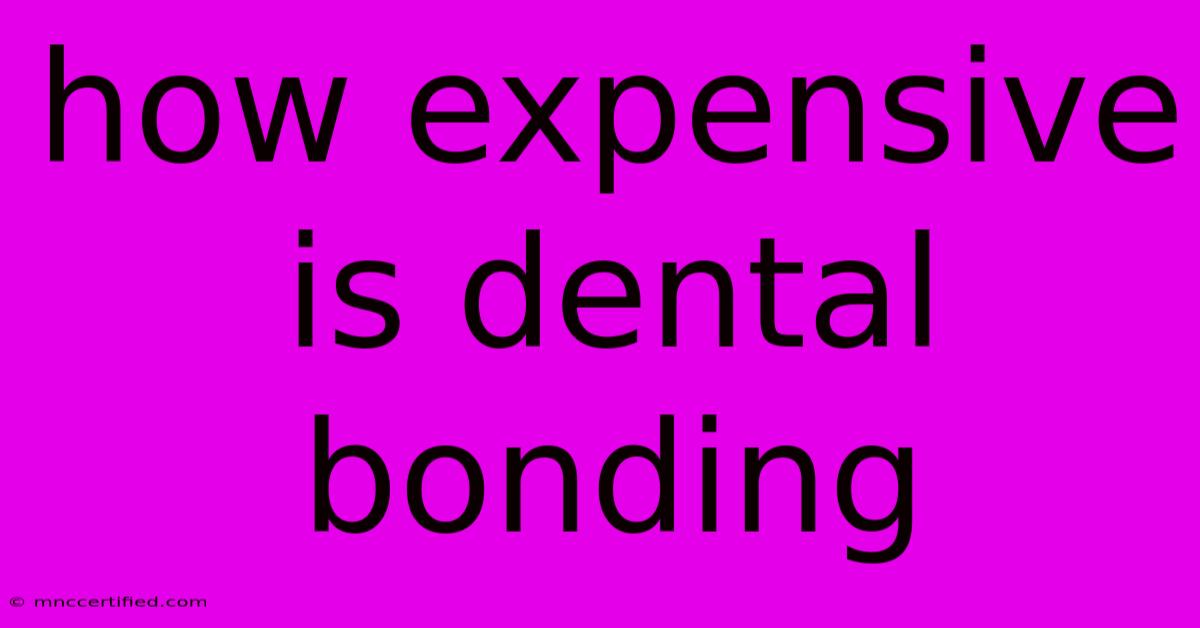How Expensive Is Dental Bonding

Table of Contents
How Expensive is Dental Bonding? A Comprehensive Guide to Costs and Factors
Dental bonding is a popular cosmetic procedure used to improve the appearance of teeth. But how much does it actually cost? The answer, unfortunately, isn't a simple number. The price of dental bonding varies significantly based on several factors. This comprehensive guide will break down the costs, influencing factors, and help you understand what to expect when budgeting for this procedure.
What is Dental Bonding?
Before diving into the cost, let's briefly explain what dental bonding entails. Dental bonding is a procedure where a tooth-colored resin material is applied to the surface of your teeth. This resin is then sculpted, hardened with a special light, and polished to seamlessly blend with your natural teeth. It's often used to:
- Repair chipped or cracked teeth: Bonding provides a quick and effective way to restore damaged teeth.
- Improve tooth color: It can mask discoloration or staining that doesn't respond well to whitening treatments.
- Close gaps between teeth: Minor gaps can be subtly filled with bonding material.
- Protect exposed tooth roots: Receding gums can expose sensitive root surfaces; bonding can offer protection.
Factors Affecting the Cost of Dental Bonding
Several factors influence the final cost of dental bonding:
1. Number of Teeth Treated:
The more teeth requiring bonding, the higher the overall cost. Bonding a single tooth is significantly cheaper than bonding multiple teeth.
2. Location of the Dental Practice:
Geographic location plays a crucial role. Dental practices in urban areas or high-cost-of-living regions typically charge more than those in rural areas. This reflects differences in overhead costs and market rates.
3. Dentist's Experience and Expertise:
Experienced and highly skilled cosmetic dentists often charge more than general dentists. Their expertise and reputation often command higher fees.
4. Complexity of the Procedure:
Simple bonding procedures, like repairing a small chip, will be less expensive than more complex procedures, such as closing larger gaps or extensively reshaping a tooth. Extensive repairs naturally require more time and material.
5. Type of Resin Used:
Different types of resin materials are available, and some are more expensive than others. The quality and durability of the resin can also affect the price.
6. Insurance Coverage:
Dental insurance may cover part or all of the cost, depending on your specific plan and the reason for the bonding (cosmetic versus restorative). Check your policy carefully before scheduling the procedure.
Average Cost Range of Dental Bonding
While a precise price is impossible to give without a consultation, a general range can be provided. In the United States, the average cost per tooth for dental bonding ranges from $300 to $600. This means that bonding multiple teeth can quickly increase the total cost to several thousand dollars.
How to Find Affordable Dental Bonding
Several strategies can help you find affordable dental bonding:
- Check for Dental Insurance Coverage: Understand your policy's coverage for cosmetic procedures.
- Compare Prices from Multiple Dentists: Obtain quotes from several dentists in your area to compare prices.
- Look for Payment Plans: Many dental offices offer payment plans to make the procedure more manageable financially.
- Inquire about Discounts or Specials: Some dental practices offer discounts for new patients or during specific promotions.
- Consider Dental Schools: Dental schools often provide affordable dental care, performed by students under the supervision of experienced dentists. However, the process may take longer.
Maintaining Your Dental Bonding
Proper care is crucial to extend the lifespan of your dental bonding. Good oral hygiene, including regular brushing, flossing, and dental checkups, will help maintain the health and appearance of your bonded teeth.
Conclusion: Planning for Dental Bonding Costs
Dental bonding is a worthwhile investment for many, enhancing smiles and confidence. However, understanding the various factors impacting its cost allows for better financial planning. By comparing prices, exploring insurance coverage, and carefully considering your options, you can achieve the smile you desire without breaking the bank. Always consult with a dentist to get a personalized assessment and accurate cost estimate for your specific needs.

Thank you for visiting our website wich cover about How Expensive Is Dental Bonding. We hope the information provided has been useful to you. Feel free to contact us if you have any questions or need further assistance. See you next time and dont miss to bookmark.
Featured Posts
-
Tenet Travel Insurance Singapore
Nov 22, 2024
-
Jude Law Star Wars Fan Confirmed
Nov 22, 2024
-
Smollett Hate Crime Case Overturned
Nov 22, 2024
-
Electric Scooter Theft Insurance
Nov 22, 2024
-
Russia Launches New Missile At Ukraine
Nov 22, 2024